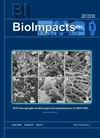苯并氮和氨基嘧啶作为神经胶质瘤患者EGFR V774M突变的多靶点治疗药物的研究
IF 2.2
4区 工程技术
Q3 PHARMACOLOGY & PHARMACY
引用次数: 0
摘要
神经胶质瘤是一种由神经胶质细胞引起的肿瘤,其侵袭性随肿瘤的分级和分期而变化。揭示EGFR基因的改变,包括扩增(未改变)、缺失和错义突变(改变),正在胶质瘤中出现。然而,对新出现的EGFR突变及其在神经胶质瘤中的作用的精确理解仍然有限。本研究旨在确定神经胶质瘤患者中普遍存在的特异性EGFR突变,并研究它们作为使用FDA批准的药物进行再利用的治疗靶点的潜力。方法:对神经胶质瘤患者的资料进行分析,以确定各种突变和生存率。利用分子对接和模拟技术对fda批准的1615种药物进行高通量虚拟筛选(HTVS),以确定潜在的靶点。结果:神经胶质瘤患者样本(n=4251)分析显示,19%的EGFR改变,大多数错义突变位于第19外显子的V774M。Kaplan-Meier图显示,未改变组的总存活率高于改变组。对接研究根据每个目标较高的对接得分、最小自由能(MMGBSA)、最小kd、ki和IC50值得出最佳命中。MD模拟及其轨迹表明,化合物ZINC000011679756靶向未改变的EGFR, ZINC000003978005靶向改变的EGFR,而ZINC000012503187 (Conivaptan, Benzazepine)和ZINC000068153186 (Dabrafenib, aminopy嘧啶)靶向两种EGFR。候选化合物表现出良好的剩余相互作用与各自的目标,形成高度稳定的配合物。此外,通过ADMET分析,这些候选化合物具有类似药物的性质。结论:因此,化合物(ZINC000012503187和ZINC000068153186)可以有效靶向未改变/改变的egfr作为神经胶质瘤的多靶点治疗药物。本文章由计算机程序翻译,如有差异,请以英文原文为准。
Unravelling benzazepines and aminopyrimidine as multi-target therapeutic repurposing drugs for EGFR V774M mutation in neuroglioma patients
Introduction: Neuroglioma, a classification encompassing tumors arising from glial cells, exhibits variable aggressiveness and depends on tumor grade and stage. Unraveling the EGFR gene alterations, including amplifications (unaltered), deletions, and missense mutations (altered), is emerging in glioma. However, the precise understanding of emerging EGFR mutations and their role in neuroglioma remains limited. This study aims to identify specific EGFR mutations prevalent in neuroglioma patients and investigate their potential as therapeutic targets using FDA- approved drugs for repurposing approach. Methods: Neuroglioma patient’s data were analyzed to identify the various mutations and survival rates. High throughput virtual screening (HTVS) of FDA-approved (1615) drugs using molecular docking and simulation was executed to determine the potential hits. Results: Neuroglioma patient samples (n=4251) analysis reveals 19% EGFR alterations with most missense mutations at V774M in exon 19. The Kaplan-Meier plots show that the overall survival rate was higher in the unaltered group than in the altered group. Docking studies resulted the best hits based on each target's higher docking score, minimum free energy (MMGBSA), minimum kd, ki, and IC50 values. MD simulations and their trajectories show that compounds ZINC000011679756 target unaltered EGFR and ZINC000003978005 targets altered EGFR, whereas ZINC000012503187 (Conivaptan, Benzazepine) and ZINC000068153186 (Dabrafenib, aminopyrimidine) target both the EGFRs. The shortlisted compounds demonstrate favorable residual interactions with their respective targets, forming highly stable complexes. Moreover, these shortlisted compounds have drug- like properties as assessed by ADMET profiling. Conclusion: Therefore, compounds (ZINC000012503187 and ZINC000068153186) can effectively target both the unaltered/altered EGFRs as multi-target therapeutic repurposing drugs towards neuroglioma.
求助全文
通过发布文献求助,成功后即可免费获取论文全文。
去求助
来源期刊

Bioimpacts
Pharmacology, Toxicology and Pharmaceutics-Pharmaceutical Science
CiteScore
4.80
自引率
7.70%
发文量
36
审稿时长
5 weeks
期刊介绍:
BioImpacts (BI) is a peer-reviewed multidisciplinary international journal, covering original research articles, reviews, commentaries, hypotheses, methodologies, and visions/reflections dealing with all aspects of biological and biomedical researches at molecular, cellular, functional and translational dimensions.
 求助内容:
求助内容: 应助结果提醒方式:
应助结果提醒方式:


